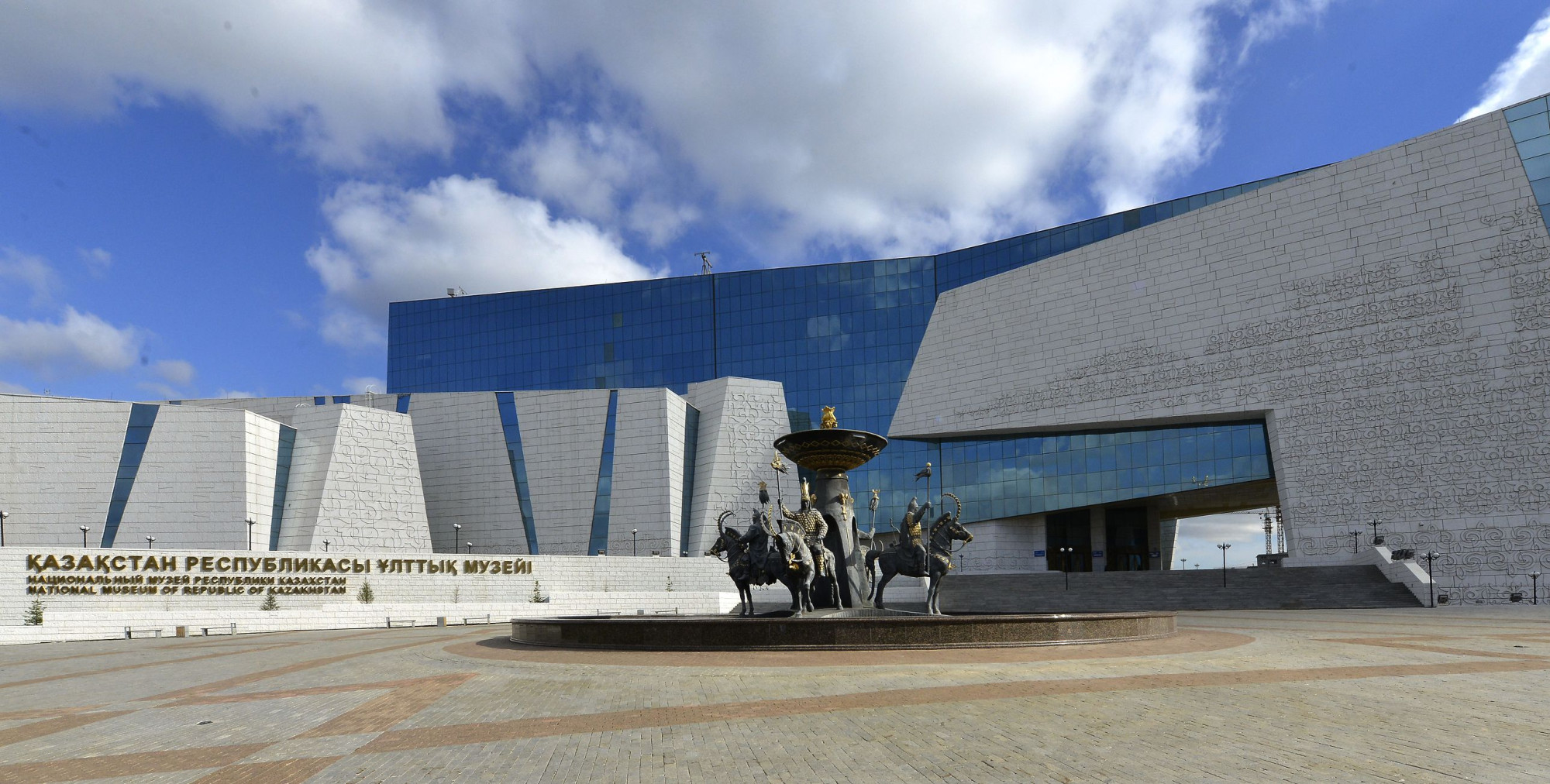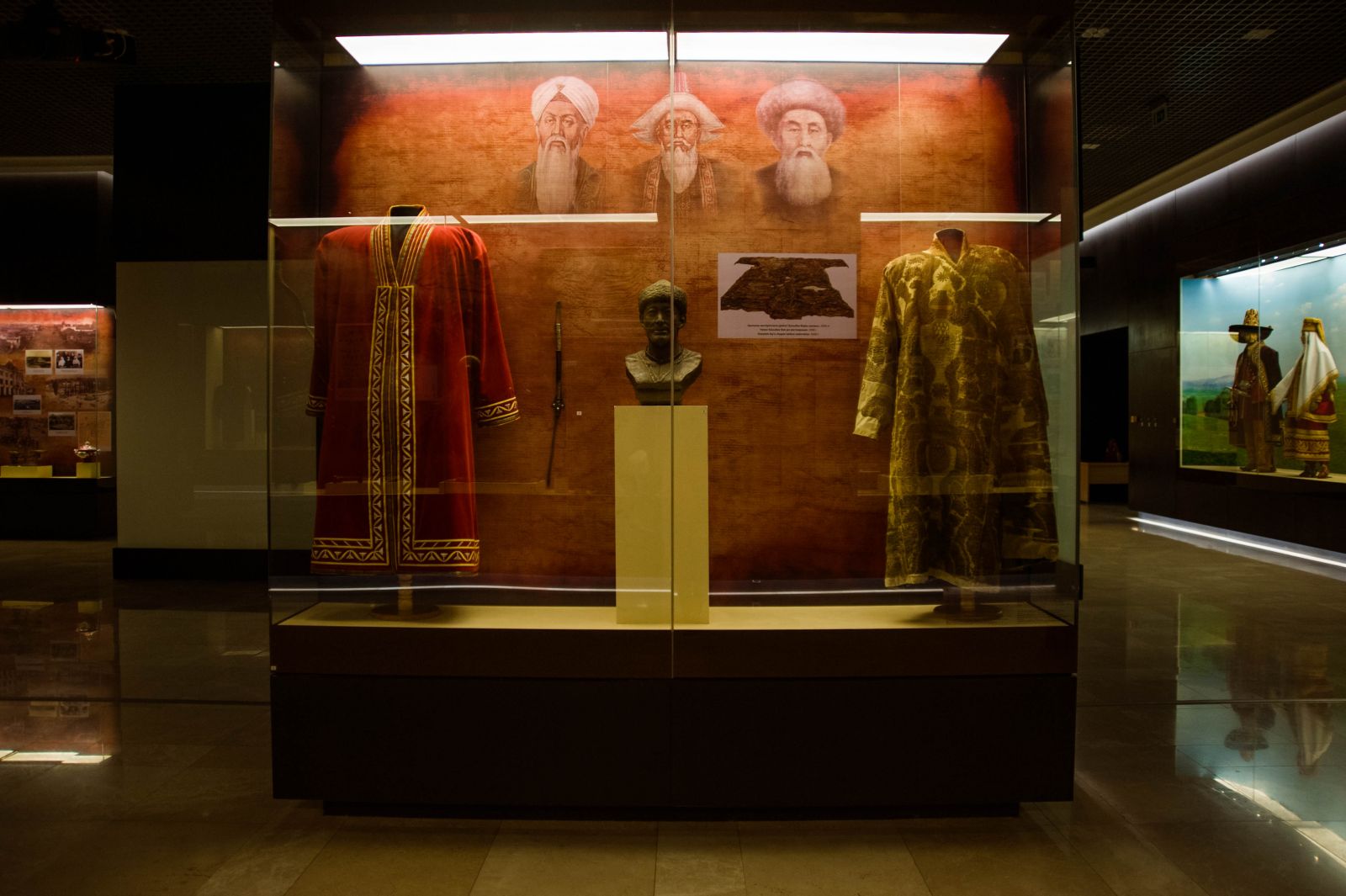The National Museum of the Republic of Kazakhstan is the largest museum in Central Asia. Created as part of the implementation of the State Program "Cultural Heritage", the museum was opened to the public on July 2, 2014. The museum complex is located on an area of 74,000 m2.
20 halls of the permanent exhibition represent the history and culture of the country from ancient times to the present day, immerse in the original culture of Kazakhstan. The museum's fund consists of more than 200 thousand items of museum collections and is annually replenished with new exhibits The museum implements cultural, educational and scientific projects to preserve, study and promote the cultural heritage of Kazakhstan, the heir to the steppe civilization and the driver of economic development of the Central Asian region. The National Museum of Kazakhstan has accumulated invaluable experience in intercultural interaction based on partnerships with cultural institutions in Central Asia, Southeast Asia, the CIS, Europe, and influential international organizations.Today, more than 2,178,119 visitors have seen the unique exhibits of the gallery.

Halls of the National Museum of the Republic of Kazakhstan:
1. Paleontology Hall
2. Hall of Ancient and Medieval History
3. The Hall of the Ancient Turkic civilization
4. Hall of Ancient Art and Technology of the Great Steppe No.1
5. Hall of Ancient Art and Technology of the Great Steppe No.2
6. Hall of History of Kazakhstan 13-20 centuries
7. Hall "Traditional culture of Kazakhs" No. 1 (hall)
8. Hall "Traditional culture of Kazakhs" No.2
9. Hall of Independent Kazakhstan
10. Astana Hall
11. Hall of Intangible Cultural Heritage
12. Ulug Ulus Hall
13. Hall "The Great Steppe at the crossroads of ancient civilizations"
14. Artisan Center
15. My Kazakhstan Children's Center
16. Hall of Fine Arts No.1
17. Hall of Fine Arts No.2
18. Multimedia room
19. The exhibition of the artist Saken Narynov "In Time and in Space"
20. Hall of Graphics and Sculpture
21.Temporary exhibition halls: "Konenin kozi" kormesi (Atrium)
In the hall "Paleontology" there are more than 200 exhibits. These are unique remains of ancient prehistoric animals, namely the skeletons of a tyrannosaurus rex, a three-toed hipparion horse, a bighorn deer, a giant rhinoceros (indricotherium), a mammoth and other creatures found by paleontologists and geologists on the territory of Kazakhstan. Additionally, the hall is equipped with modern information equipment – touchscreens with information about the development of the animal and plant world of Kazakhstan in the prehistoric period.
In the hall "Ancient and medieval history" you will learn about the history of Kazakhstan, starting from ancient times: from the Stone Age and up to the developed Middle Ages. The exposition of the hall is represented by 4 thematic blocks: the Stone Age, the Bronze Age, the Early Iron Age and the Middle Ages, and one subsection devoted to anthropological studies of the ancient population of Kazakhstan.
The hall of the "Ancient Turkic Civilization" presents the material and spiritual culture of the Turks, who created a huge military empire in the vast expanses of the Great Steppe. The first part of the exposition of the hall is devoted to written culture, which is a vivid evidence of the high level of the developed Turkic civilization.The next part of the exhibition presents stone sculptures that show the ideological ideology of the ancient Turks. The third part of the exhibition presents archaeological finds related to the monuments of the Middle Ages.
The exposition of the hall "Ancient art and technology of the Great Steppe" presents artifacts from the Bronze Age, Early Iron Age and Late Middle Ages, revealing the history and culture of our country.
The exposition of the hall "The History of Kazakhstan of the 13th-20th centuries" covers the period from the beginning of the formation of the Kazakh Khanate to the formation of an independent state - the Republic of Kazakhstan. The centuries-old history of the Kazakh people is presented here.
The exposition of the hall "Traditional culture of the Kazakhs" No.1 is designed to display all the richness and splendor of the long-term historical traditions of the Kazakhs embodied in the works of material and spiritual culture.
Hall "Traditional culture of the Kazakhs" No.2 represents the decorative and applied art of the Kazakh people, traditions and the customs of a nomadic civilization, national values.
The hall of "Independent Kazakhstan" reflects the history from the moment the republic was declared an independent state to the present day. The history, politics, economy, culture and art of the country are widely and comprehensively represented in the hall.
Astana strong Hall is a systematic collection of the most important normative legal acts, exhibits, photographic and documentary materials reflecting the history of the emergence, formation and development of the city as the capital of independent Kazakhstan.
"Ulyk Ulys" zalyn expositionsynda Altyn Orda memleketi men Kazakh khandygyn tikelei sabaktastygyn korsetetin biregey zhadigerler usynilgan.
In the exhibition hall "Ulug Ulus" presents unique exhibits reflecting the direct continuity of the Golden Horde state and the Kazakh Khanate.
Exhibition of architect Saken Narynov "In Time and in Space"presents to the viewer the unique worldview of the artist and his unique mathematical style. Saken Narynov worked at the junction of science and art. As an artist, architect, sculptor and philosopher, he created not only works of aesthetic value, but also complex technical inventions.
"The Great Steppe at the crossroads of ancient civilizations."The exposition of the hall introduces the masterpieces of ancient art of the East and West, the appearance of which is the result of cultural and trade relations between the nomadic world and the agricultural peoples of Eurasia.
Intangible cultural heritage of the Republic of Kazakhstan – customs, forms of representation and expression, knowledge and skills, as well as related tools, objects passed down from generation to generation and being an intangible cultural value. Intangible cultural heritage is also called "living heritage", which defines the identity of a people, an ethnic group, and promotes the development of creativity and social well-being.
The Artisans Center presents the best works of decorative and applied art created by modern domestic craftsmen. This center is based on the artistic model of the ancient cities of the Great Silk Road. In addition, there is an opportunity to get to know handicrafts better, learn about manufacturing techniques and even purchase items you like.
Multimedia room. In this hall, you can get acquainted with the historical and cultural heritage of the Kazakh people with the help of modern technologies. The purpose of multimedia equipment is to support and develop audience interest by presenting historical collections in a modern format.

An interesting fact.In 2023, the dagger "Jambiya", which belonged to the first Kazakh professional wrestler, was transferred to the fund of the National Museum of the Republic of KazakhstanKazhymukan Munaitpasov.
In 1909-1911, K. Munaytpasov successfully performed in fights with the strongest Turkish wrestlers. The trip turned out to be fateful for the athlete: as a recognition of his strength and talent, during this tour, the prefix "Kazhi" ("Hajji") appeared in his name – who made a pilgrimage to holy places.
On both sides of the dagger, the following is written in Arabic letters in the ancient Turkic-Ottoman language: on the left - "the mighty, invincible son of Munaitpas, the great Mukan", and on the right - "in memory of us, about the pilgrimage, Shagyr Pasha, 1330". If we count the year "1330" engraved on the dagger as the year of the Hijra, then according to modern chronology it is 1912. Those were the times when Kazhymukan, as a real professional wrestler, became famous all over the world.
The "Shagyr Pasha" engraved on the dagger is the ruler of Istanbul, and the word "hajji" indicates pilgrimage to holy places, and the dagger itself could have been made by one of the Yemeni craftsmen near Mecca. In short, historical data indicate that this dagger was presented to Kazhymukan.
The museum is located at:54 Tauelsizdik ave., Astana
The architect of the building is Vladimir Laptev, a member of the Union of Architects of Kazakhstan. The architect started from the idea of a waving flag.




